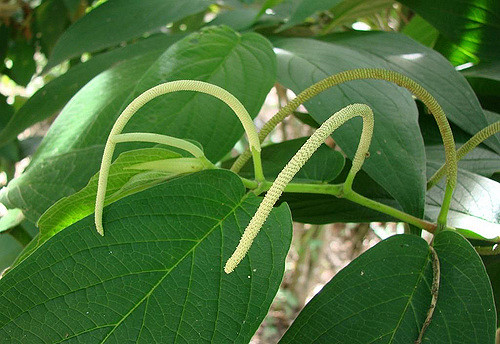by Piter Kehoma Boll
A relative of the famous black pepper from India that is used as a spice worldwide, today’s fellow, the spiked pepper Piper aduncum, comes from South America, where it is also called by other names such as matico and higuillo de hoja menuda.
Growing as a small tree or shrub, the spiked pepper is widespread throughout the continent, being found in both the Atlantic and the Amazonian forests. Having a peppery odor as other peppers, it can be used as a substitute of them while preparing food, but its main uses are medicinal.

Close up of a branch of Piper aduncum showing the inflorescences. Photo by João Medeiros.*
It is classically used by local populations as an antiseptic applied directly on open wounds and also as an infusion or paste to treat gastrointestinal disorders and problems of the genital organs. Laboratory studies using extracts from the plant concluded that it has antibacterial and moluscidal properties, thus having the potential to be used as both an antiseptic and a pesticide against mollusks.
Outside of South America, the spiked pepper became a problematic invasive species in several islands of the Pacific, such as New Guinea and Fiji. In Papua-New Guinea, it has become so common that it was incorporated in the culture of local people, who use it as a wood source and as a medicine and pesticide.
– – –
References:
Maia, J., Zohhbi, M., Andrade, E., Santos, A., da Silva, M., Luz, A., & Bastos, C. (1998). Constituents of the essential oil ofPiper aduncum L. growing wild in the Amazon region Flavour and Fragrance Journal, 13 (4), 269-272 DOI: 10.1002/(SICI)1099-1026(1998070)13:43.0.CO;2-A
Orjala, J., Wright, A., Behrends, H., Folkers, G., Sticher, O., Rüegger, H., & Rali, T. (1994). Cytotoxic and Antibacterial Dihydrochalcones from Piper aduncum Journal of Natural Products, 57 (1), 18-26 DOI: 10.1021/np50103a003
Potzernheim, M., Bizzo, H., Silva, J., & Vieira, R. (2012). Chemical characterization of essential oil constituents of four populations of Piper aduncum L. from Distrito Federal, Brazil Biochemical Systematics and Ecology, 42, 25-31 DOI: 10.1016/j.bse.2011.12.025
Siges, T., Hartemink, A., Hebinck, P., & Allen, B. (2005). The Invasive Shrub Piper aduncum and Rural Livelihoods in the Finschhafen Area of Papua New Guinea Human Ecology, 33 (6), 875-893 DOI: 10.1007/s10745-005-8214-7
– – –
*
This work is licensed under a Creative Commons Attribution 2.0 Generic License.
